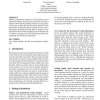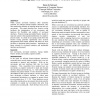CORR
2008
Springer
14 years 15 days ago
2008
Springer
Popular computational models of visual attention tend to neglect the influence of saccadic eye movements whereas it has been shown that the primates perform on average three of th...
NIPS
2003
14 years 1 months ago
2003
Recent eye tracking studies in natural tasks suggest that there is a tight link between eye movements and goal directed motor actions. However, most existing models of human eye m...
NIPS
2001
14 years 1 months ago
2001
Neural activity appears to be a crucial component for shaping the receptive fields of cortical simple cells into adjacent, oriented subregions alternately receiving ON- and OFF-ce...
NIPS
2004
14 years 1 months ago
2004
We propose a sequential information maximization model as a general strategy for programming eye movements. The model reconstructs high-resolution visual information from a sequen...
APVIS
2007
14 years 1 months ago
2007
Graphs are typically visualized as node-link diagrams. Although there is a fair amount of research focusing on crossing minimization to improve readability, little attention has b...
ITS
2000
Springer
14 years 4 months ago
2000
Springer
The ability of an ITS to develop an accurate student model is inherently limited by the bandwidth of information available. We have completed an exploratory research project showin...
CHI
1999
ACM
14 years 4 months ago
1999
ACM
While current eye-based interfaces offer enormous potential for efficient human-computer interaction, they also manifest the difficulty of inferring intent from user eye movements...
HICSS
2002
IEEE
14 years 5 months ago
2002
IEEE
Individual differences make it difficult to recognize similarities between individuals in eye movement patterns. However, if consistencies can be found, eye movements could be use...
WAPCV
2004
Springer
14 years 5 months ago
2004
Springer
Abstract. This paper proposes a neuronal-based solution to active visual search, that is, visual search for a given target in displays that are too large in spatial extent to be in...
NIME
2004
Springer
14 years 5 months ago
2004
Springer
Though musical performers routinely use eye movements to communicate with each other during musical performances, very few performers or composers have utilized eye tracking devic...





